Focusing on increasing your revenue growth rate is essential to achieve startup success. This ultimate guide provides tips and strategies that you can use to help your business grow. By following these steps, you will see an increase in sales and expand your customer base. You can also apply the advice provided in this guide to improve your company’s overall performance. So, if you are looking for ways to take your startup to the next level, read this helpful guide!
What Is A Revenue Growth Rate?
The revenue growth rate is one of the most important indicators of a company’s health. It shows how well a company is able to grow its sales revenue over time. Revenue growth rates can be compared year-over-year or quarter-over-quarter. Established companies might be more focused on year-on-year growth rates.
A higher growth rate generally indicates that the company is doing well and may see continued growth in the future. In comparison, a lower or negative growth rate could signal potential trouble for the business.
It’s important to note that this metric doesn’t necessarily tell the whole story; for example, a high revenue growth rate might only be achieved through unsustainable methods such as cutting expenses or cutting corners on quality.
As with any financial statistic, it should be considered along with other metrics for a thorough understanding of a company’s status.
Why Is It Important For Startups To Track This Metric?
As a startup, it is crucial to track your revenue growth rate to make informed decisions about the future of your business.
With this information, you may realize that one of your products or services is underperforming or that there are specific markets where your offerings are particularly successful. This data can also help you set realistic goals and allocate resources efficiently.
Tracking your revenue growth rate allows you to adjust and improve current strategies and serves as a point of reference for investors seeking funding or possible partnerships.
Here are the five reasons startups should track their Revenue Growth Rate:
1. Better Decision Making:
Tracking your Revenue Growth Rate allows you to analyze trends in sales, identify opportunities for improvement and make informed decisions about the future of your business.
2. Improve Cash Flow Management:
If you’re able to track your Revenue Growth Rate, then it will be easier to predict when sales cycles are likely to increase or decrease, allowing you to better manage cash flow.
3. Identify Bottlenecks:
By tracking your Revenue Growth Rate, you can identify areas where sales are not increasing as quickly as expected and take action to address any bottlenecks that might be hindering growth.
4. Enhance Investor Relations:
Tracking your Revenue Growth Rate can help you demonstrate the potential of your business to investors, showing them that you are committed to building a successful company.
5. Create Goals:
Tracking your Revenue Growth Rate allows you to create realistic goals for your business and evaluate whether or not these goals have been met. This information is invaluable for creating an effective plan for achieving your desired level of growth.
So if you still need to keep track of this metric, now is the time to start. It could have a significant impact on the success of your startup.
How Can You Calculate Your Revenue Growth Rate?
The Revenue Growth Rate can be calculated by taking the current period’s revenue, subtracting the prior period’s revenue, then dividing that number by the prior period’s revenue and multiplying by 100.
Here’s the formula:
[ ($) Revenue Month B – ($) Revenue Month A ] / ($) Revenue Month A X 100 = (%) Revenue Growth Rate
This formula can be applied to different periods, such as annually or quarterly. Not only does it show an increase in revenue, but it also measures any decrease in growth.
Let’s take an example. For an ABC Company, that’s:
(January 2022 Revenue – December 2021 Revenue) / December 2021 Revenue x 100
Numerically, it will be:
($100,000 – $96,000) / $96,000 x 100
Ultimately, it will lead to $4,000 / $96,000 = 0.0417. The ABC Company’s growth will be almost 4.17% when multiplied by 100.
For early-stage startups, tracking weekly revenue growth will be more helpful to gauge progress given the lack of trading history. Replace monthly revenue with weekly revenue to get the equivalent.
[ ($) Revenue Week B – ($) Revenue Week A ] / ($) Revenue Week A X 100 = (%) Weekly Revenue Growth Rate
What Is A Good Revenue Growth Rate?
A “good” revenue growth rate ultimately depends on the context of your specific company and industry. A mature, established business may be happy with steady 10-15% growth, while a newer startup may aim for 30-40% or higher (on a monthly basis!).
Jason Lemkin suggests that most Saas companies take 7-10 years to grow from $1 million ARR to over 100M annually and that an MRR growth rate of 15-20% is a pretty good target for post-Seed/pre-Series A SaaS startups to have.
There are two heuristics to bear in mind:
- 3T2D: This means you should triple 3x and then 2x twice to get to $100m ARR
- Rule of 40%: A SaaS company’s combined revenue growth rate and profit margin should equal or exceed 40%
Equidam did some research in 2019 and found that growth rates varied a lot by age, sector, and country.
Age of startup
The average company forecasts a growth rate of 178% in revenues for their first year, 100% for the second, and 71% for the third.
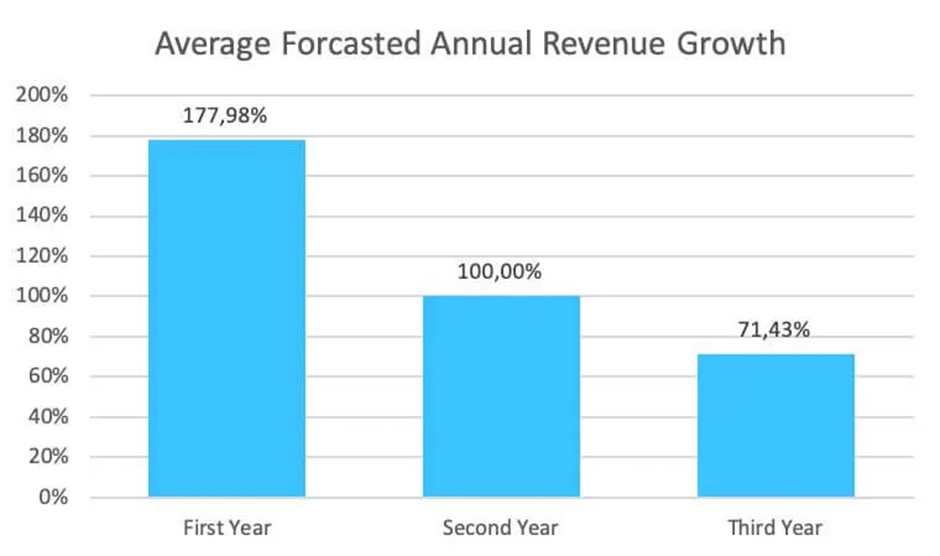
Size and country matter
Smaller companies grow around 200-300% a year.
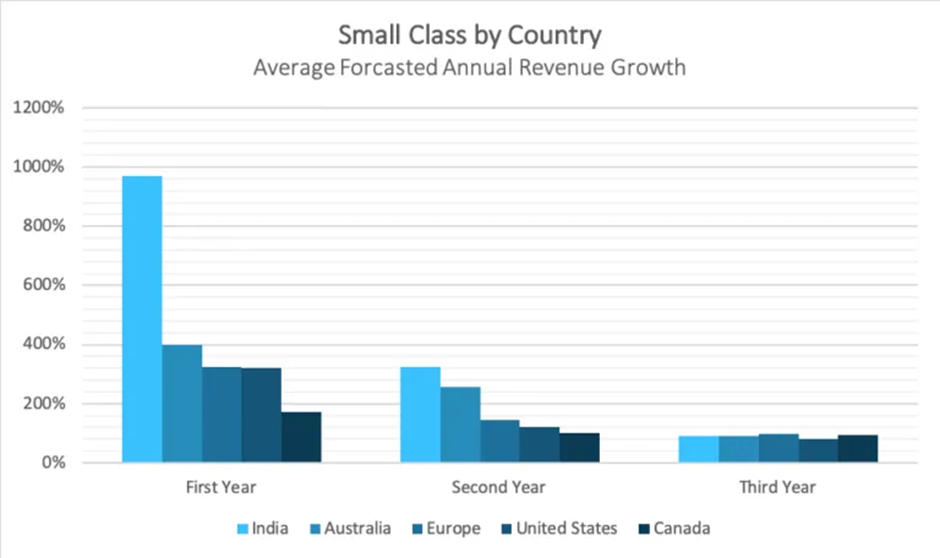
Larger companies grow slower.
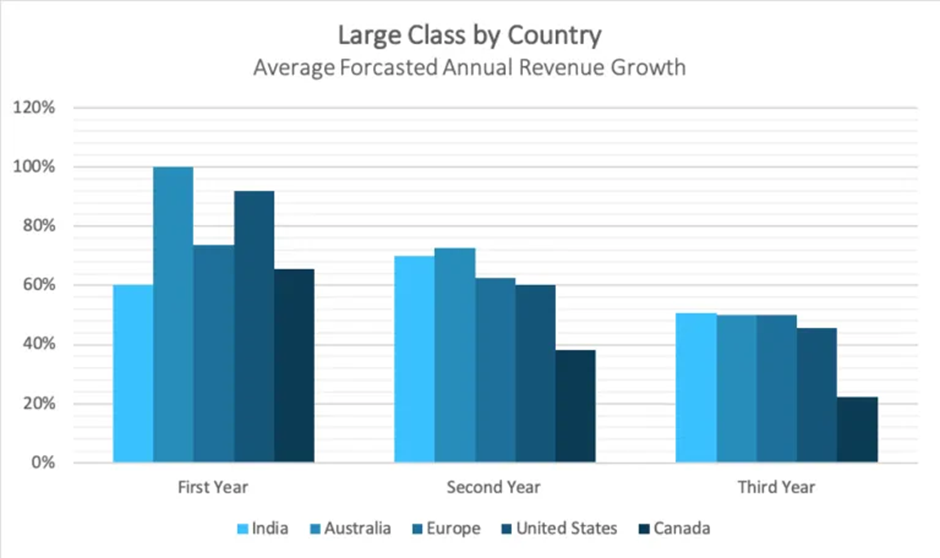
Sector
Different sectors that startups operated in varies.
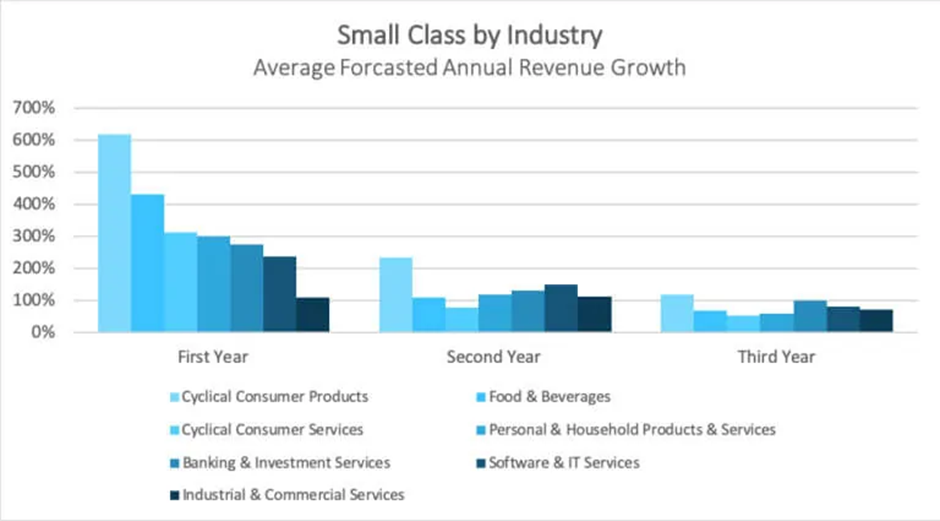
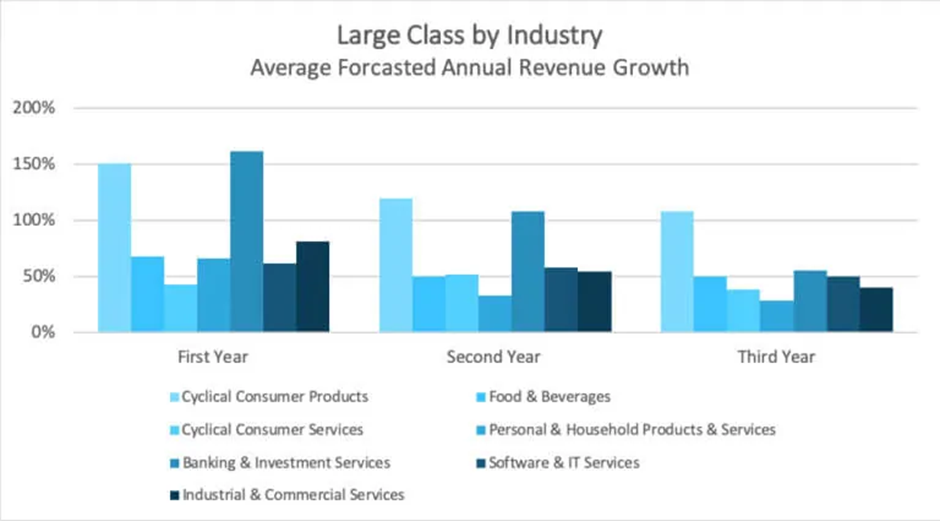
However, it’s important to note that extremely high growth rates can also signal red flags – unsustainable practices such as aggressive pricing and excessive spending. Your best bet is to set realistic targets based on industry benchmarks and your specific situation.
VC thoughts on the Revenue Growth Rate
“If there’s one number every founder should always know, it’s the company’s growth rate. That’s the measure of a startup. If you don’t know that number, you don’t even know if you’re doing well or badly… The best thing to measure the growth rate of is revenue. The next best, for startups that aren’t charging initially, is active users. That’s a reasonable proxy for revenue growth because whenever the startup does start trying to make money, their revenues will probably be a constant multiple of active users.”
– Paul Graham, VC and Co-Founder of Y Combinator
“If a startup has a basic product or is looking for market fit, then one of the top three metrics I always ask for is MoM (Month on Month) Revenue Growth.”
– William McQuillan, Partner at Frontline Ventures
“The ability to accelerate monthly revenues while decreasing monthly burn is the #1 thing I look for in a growth stage business.”
– Steve Schlenker, Managing Partner at DN Capital
7 Strategies To Increase Revenue Growth Rate For Startup Metrics
For a startup, it is important to increase the revenue growth rate in order to achieve profitability and long-term success.
Here are seven strategies that can help increase your revenue growth rate:
Increase your prices
This is perhaps the simplest and most direct way to increase revenue growth. If you’re selling products or services in high demand, you may get away with charging more for them.
Introduce new products or services
Another way to boost revenue growth is by offering new products or services that complement your existing offerings. This can help you tap into new markets and attract new customers.
Improve your marketing efforts
You will only see growth if you get the word out about your business. Investing in marketing efforts like search engine optimization, social media marketing, and content marketing can help you reach a wider audience and generate more leads.
Enhance your sales process
If your sales team isn’t closing deals, you will not see any growth. Train your sales staff on the latest techniques and give them the tools they need to be successful.
Improve customer retention
It’s cheaper to keep existing customers than to acquire new ones. Developing strategies to improve customer retention can help boost your revenue growth.
Increase your average order value
If you can get your customers to spend more per transaction, you’ll see a corresponding increase in your revenue growth. There are a few ways to do this, such as upselling and cross-selling.
Expand into new markets
If you’re only selling to customers in your local market, you’re limiting your potential growth. Look for opportunities to expand into new markets, either domestically or internationally.
By following these seven strategies, you can help ensure that your startup continues to see strong revenue growth.
What to Look for in Software Platforms to Increase Your Revenue Growth Rate?
When selecting a software platform to increase revenue growth, looking for dynamic, real-time visibility is essential. This means seeing the big picture and granular data at any moment.
The platform should also optimize sales and marketing performance by tracking historical data and current activities and providing comprehensive revenue forecasting. Automation of these forecasts can save time and improve reliability.
There are a number of software platforms that can help startups to increase their revenue growth rate. One such platform is Salesforce, which helps businesses to track and manage their sales pipeline. Another platform is HubSpot, which helps businesses to create and track marketing campaigns. These platforms and others can help startups to accelerate their revenue growth and achieve profitability and long-term success.
Ultimately, choosing a platform with these capabilities can significantly support your efforts to focus resources on core revenue drivers and secure future growth. Keep in mind that transparency is also crucial – you want to be able to trust the data and insights the platform provides. Choosing wisely sets you up for success in reaching your revenue goals.
Tips For Tracking Your Startup’s Revenue Growth Rate
As a startup business owner, tracking your company’s revenue growth rate is essential to make informed decisions about future expenditures and investments. Here are a few tips to help you monitor this crucial metric:
- First, establish and clearly define revenue growth for your team.
- This should include whether you are tracking gross or net gain, what period you will use to measure, and if any specific sources or products will be excluded.
- Next, gather data regularly (weekly or monthly is usually recommended) and store it in an easily accessible format.
- When analyzing your findings, focus on percentage changes rather than absolute numbers, as this can provide valuable insight into the overall trend of your startup’s revenue growth.
- Finally, use this information to assess past performance and inform future planning and decision-making.
Wrap Up
Your startup’s revenue growth rate is the key to your business’ success. By following the guide above, you can take charge of this essential metric and ensure that your startup is on track to achieve its long-term goals. With a little planning and effort, you can ensure that your startup grows sustainably and healthily.


Comments 1
Just dropping a note here that we’ve updated the average growth rate article that you reference here.
It would be nice if you included a link to the source: https://www.equidam.com/average-growth-rate-for-startups/